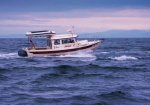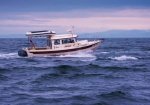colbysmith
Active member
- Joined
- Oct 2, 2011
- Messages
- 5,038
- Reaction score
- 15
- C Dory Year
- 2009
- C Dory Model
- 25 Cruiser
- Hull Identification Number
- UWH25301J809
- Vessel Name
- C-Traveler
Yes, if the pump is big enough!
A little more clarification on my earlier comments. My first autopilot was the RayMarine EV100. I forget what it's pump displacement was, but it was not enough to quickly turn the outboard as necessary in waves, chop or wind. It was really only good for going straight on a very calm day, at least when trolling. Eventually, and before heading up to Alaska, I got the Garmin Reactor 40 with the smart pump. That AP could hold the boat on course better than I could. And it could do it in reverse if you wanted it too. Even trolling (2-3mph) in 2 foot waves, or with wind, the thing could hold course. How good is it? I'd use it to run a track in the Blue Creek off the St. John's River by Astor. If you're not familiar with that, think very narrow and winding! I did transfer that autopilot from my 22 to my 25, and just as happy with it. I think the trick with autopilots is to get one with a pump big enough to handle your hydraulic system. It can then steer the boat at whatever speeds you are able to. Maybe better. Colby



